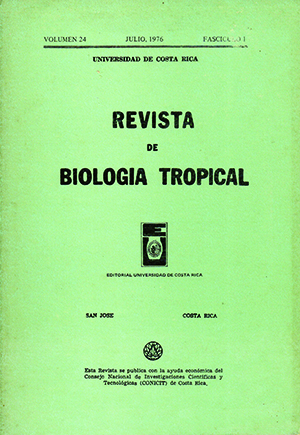Abstract
Observations from October 1965 to May 1967, on the role played by mollusks and other invertebrates in the transmission of Angiostrongylus cantonensis infection to man on the South Pacific island of New Caledonia revealed that various snails, slugs and a planarian, ocurring in gardens supplying considerable amounts of edible green vegetation to local markets, were commonly infected with third-stage larvae of A. cantonensis. The veronicellid slugs, Vaginulus plebeius and Laevicaulus alte, were the most frequently and intensively infected mollusks and they probably serve as the chief reservoir of infection for feral rats. The high level of infection in these slugs not only results in maintaining a large population of infected rats but is of importance in the dispersal of infective larvae into planarians serving as paratenic hosts for the parasite. There is no apparent seasonal diference in the rate and level of infection among the slugs, although they have a dormant period during the cooler months (July to September) of the year. It is suggested that planarians are probably the single most important source of human infection in New Caledonia. The planarians show a marked seasonal occurrence, reaching their peak during the cool months of the year, which corresponds to the peak vegetable growing season. Their highly carnivorous habits in their attacking of both snails and slugs results in a high level of infection although individual planarians harbor relatively low numbers of larvae, usually less than 10. Their small size, their ability to fragment easily, and their rapid dehydration to form inconspicuous black masses contaminating lettuce and other vegetables make them an ideal vehicle for the transmission of A. cantonensis to man.
References
Alicata, J. E. 1962. Angiostrongylus cantonensis (Nematoda: Metastrongylidae) as a causative agent of eosinophilic meningoencephalitis of man in Hawaii and Tahiti. Canad. J. Zool., 40: 5-8.
Alicata, J. E. 1963. The incidence oi Angiostrongylus cantonensis (Chen) among rats and mollusks in New Caledonia and nearby islands and its possible rela tionship to eosinophilic meningitis. South Pacific Commission Technical Paper No. 139: 1-9.
Alicata, J. E. 1964. Pigs and calves as carrier hosts for the infective larvae of Angiostrongylus cantonensis J. Parasitol., 50 (3, Sect. 2): 39.
Alicata, J. E. 1965. Notes and observations on murine angiostrongylosis and eosinophilic meningoencephalitis in Micronesia. Canad. J. Zool., 43: 667-672.
Alicata, J. E., & K. Jindrak 1970. Angiostrongylosis in the Pacific and Southeast Asia. Charles C. Thomas, Springfield, Illinois.
Ash, L. R. 1968. The occurrence of Angiostrongylus cantonensis in frogs of New Caledonia with observations on paratenic hosts of metastrongyles. J. Parasitol., 54: 4 32436.
Ash, L. R. 1970. D iagnostic m orphology of the third-stage larvae of Angiostrongylus cantonensis, Angiostrongylus vasorum, A elurostrongylus abstrusus, and A nafilaroides rostratus (Nematoda: Metastrongyloidae). J. Parasitol., 56: 249-253.
Cheng, T. C., & J. E. Alicata 1964. Possible role of water in the transmission of Angiostrongylus cantonensis (Nematoda: Metastrongylidae). J. Parasitol., 50: 3940.
Heyneman, D., & B. L. Lim 1965. Prolonged survival in rats immunized by a small number of low-level doses of Angiostrongylus cantonensis and challenged with a lethal level of infective larvae. Med. J. Malaya., 20: 162-163.
Heyneman, D. & B. L. Lim 1967 Angiostrongylus cantonensis: proof of direct transmission with its epidemiological implications. Science, 158: 1057-1058.
Lim, B. L., & D. Heyneman 1965. Host-parasite studies of Angiostrongylus cantonensis (Nematoda, Metastrongylidae) in Malaysian rodents: natural infection of rodents and molluscs in urban and rural areas of central Malaya. Ann. Trop. Med. Parasitol., 50: 425-433.
Malek, E. A. 1962. Laboratory guide and notes for medical malacalogy. Burgess Co., Minneapolis, Minnesota, 154 pp.
Punyagupta, S., T. Bunnag, P. Juttijudata, & L. Rosen 1970. Eosinophilic meningitis in Thailand. Epidemiologic studies of 484 typical cases ami the etiologic role of Angiostrongylus cantonensis. Amer. J. Trop. Med. Hyg., 19: 950-958.
Rosen, L., J. Laigret, & S. Bories 1961. Observations on an ou tbreak of eosinophilic meningitis on Tahiti, French Polynesia. Amer. J. Hyg., 74: 26-42.
Rosen L., G. Loison, J. Laigret, & G. D. Wallace 1967. Studies on eosinophilic meningitis. III. Epidemiologic and clinical observations on Pacific islands and the possible etiologic role of Angiostrongylus cantonensis. Amer. J. Epidemiol., 85: 1744.
Wallace, G. D., & L. Rosen 1966. Studies on eosinophilic meningitis. II. Experimental infection of shrimp and crabs with Angiostrongylus cantonensis. Amer. J. Epidemiol., 84: 120-131.
Wallace, G. D., & L. Rosen 1967. Studies on cosinophilic meningitis. IV. Experimental infection of fresh-water and marine fish with Angiostrongylus cantonensis. Amer. J. Epidemiol., 85: 395-402.
Wallace, G. D., & L. Rosen 1969. Experimental infection of Pacific island mollusks with Angiostrongylus cantonensis. Amer. J. Trop. Med. Hyg., 18: 13-19.
Wallace, G. D., & L. Rosen 1969b. Studies on eosinophilic meningitis. V. Molluscan hosts of Angiostrongylus cantonensis on Pacific islands. Amer. J. Trop. Med. Hyg., 18: 206-216.
Wallace, G. D., & L. Rosen. 1969. Techniques for recovering and identifying larvae of Angiostrongylus cantonensis from molluscs. Malacalogia. 7: 427-438.
Yii, C. -Y. Chen, E. -R. Chen, H. -C. Hsieh, C. -C. Shih, J. H. Cross, & L. Rosen 1975. Epidemiologic studies of eosinophilic meningitis iin southern Taiwan. Amer. J. Trop. Med. Hyg., 24: 447-454.
Comments

This work is licensed under a Creative Commons Attribution 4.0 International License.
Copyright (c) 1976 Revista de Biología Tropical


